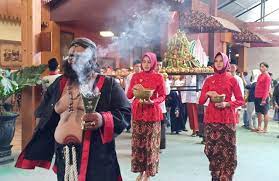The economic sector in the world experienced a significant negative impact due to the COVID-19 pandemic. This virus has become a global pandemic and spread to various countries, including Indonesia. As a result, the global economic growth experienced negative growth of -4.9% in 2020 (IMF, 2020). Meanwhile, Indonesia’s 2020 economic growth contracted by 2.07 percent compared to 2019 (BPS, 2021). The negative economic growth was also occurring at the sub-national level. In this case, Blitar Regency in 2020 experienced a growth contraction of 2.29%, larger than the contraction at the national level (BPS Blitar Regency, 2020).
Blitar is an area known for its diverse tourism sector (Lathifaturrohmah et al., 2021). One of the tourist attraction types in Blitar is cultural tourism. There is an intangible cultural heritage in Blitar, such as the tradition of Larung Sesaji at Tambakrejo Beach, Reog Bulkiyo, Jamasan Kyai Pradah, and Grebeg Pancasila. The cultural heritage objects in this area include Sawentar Temple, Gedog Temple, Penataran Temple, Simping Temple, Gebang Palace, and the tomb of Soekarno, the proclaimer of Indonesia’s independence (Hartono, 2020). In addition, there are various Blitar specialities, including staple foods (punten and ampok rice), meat-based side dishes (peyek uceng and kuthuk fish), vegetable side dishes in the form of seasoned tofu, soup (lodeh tewel soup), sepinggan (rujak cingur and Soto soup), snacks (wajik klethik, geti and opak gambir), and drinks in the form of Pleret ice.
The diversity of cultural heritage in Blitar has the potential to be utilised by the community and the local government. The utilisation is not only limited to historical and philosophical values but also in terms of economic value through the development of cultural-based tourism. Cultural tourism can create jobs and also contributes to regional revenue. However, the COVID-19 pandemic significantly reduces the tourism sector due to the restrictions to curb the spread of the virus. The tourism sector in Blitar was no exception. This paper examines the impact of the decrease of tourist visits to cultural heritage objects in the Blitar area due to the COVID-19.
The tourism industry plays an important role in the Indonesian economy at the district, province and national levels. The industry has been the source of revenue generation, employment creation and the development and transfer of human capital, all of which are essential to economic growth. However, little empirical work has been conducted to explore the nature of the relationship between tourism demand and economic growth at the subnational level in Indonesia. This paper seeks to fill this critical gap in the literature by analysing the relationship of tourism, GRDP, GRDP growth, inflation and also include the shock caused by the COVID-19 pandemic. In this case, we focus our study on the Blitar Regency using the monthly data from 2015 to 2020. We use time series analysis procedures, starting by examining the stationary of the data of the variables, testing the cointegration, and estimating the relationship of the variables using the VECM method.
From the results of this study, it can be concluded that the COVID-19 pandemic has dramatically affected the economic sector and cultural tourism in the Blitar district. The impacts experienced by the cultural tourism sector include a significant decrease in the number of tourist visits, resulting in a reduced turnover of traders and MSMEs. The estimation results show that cultural tourism has a significant impact both on the GDRP and the GRDP growth Blitar district. Meanwhile, the COVID-19 pandemic directly impacts the surrounding community’s economy because many destinations and industries have to temporarily close during the pandemic. The negative effect even causes some businesses to have to close permanently. As a result, many people around tourist destinations have lost their livelihood sources. This issue requires sustainable tourism development, such as the procurement of virtual tourism, promotion, and improvement of tourist-related infrastructure to prepare for the tourist return after the pandemic.
The quality of tourist-related infrastructure, such as local amenities like roads, airports, transit systems, heritage sites, national parks, museums, and other tourism attractions, is an essential predictor of tourism demand. Improving economic growth and real GRDP could help to improve the quality of tourist-related infrastructure and contribute to the tourism sector’s long-term growth. At the macro level, the provincial and central governments may choose to emphasize infrastructure improvement projects to stimulate economic growth, benefiting the tourism industry. Aside from general infrastructure, money allocation priority should include, for example, enhancing the quality of water supply, trash disposal, and energy supply, all of which contribute significantly to economic growth. Focusing on these components of economic growth could also assist boost the tourism sector, as the availability of these public services directly impacts the attractiveness of a tourist destination.
An improving economy is also linked to a more favourable business environment, which encourages the growth of tourism-related companies like hotels, restaurants, and shopping malls, thereby drawing more international visitors to the country. This condition will necessitate government agencies to develop programs that encourage investors to invest in restaurants, bars, and other entertainment venues. In addition, local governments may also choose to consider public-private partnerships, which have been found to boost the efficiency of government investment while simultaneously reducing the problem of underinvestment caused by information asymmetry when left alone to the private sector (Chauhan and Marisetty, 2019). Moreover, given their previous visit, the services supplied by these industries may impact tourists’ intention to return.
Author: Ilmiawan Auwalin, Alissa Qadrunnada, Rezhi Vauzi & Siti Arifah
This article is summarized from the journal article titled: “Impact of Decrease in Cultural Tourism Visits on Gross Regional Domestic Product of Blitar Regency During the COVID-19 Pandemic” that have been published on Journal of Indonesian Applied Economics. Journal article can be accessed on: https://jiae.ub.ac.id/index.php/jiae/article/view/392





